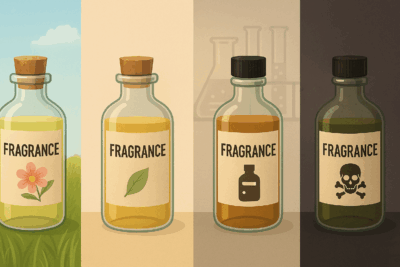
It sounds so simple — but that one word might hide thousands of undisclosed chemicals.
In the world of personal care, few words are as deceptively innocent as “fragrance.” Listed as a single ingredient, it seems straightforward. But dig deeper and you’ll discover a complex and often concerning truth: that one word can represent a cocktail of up to thousands of chemicals — many of which are hidden from consumers under trade secret protections.
A Trade Secret with Serious Consequences
Under current U.S. law, companies are not required to disclose the components of fragrance mixtures, citing intellectual property protections. This means that even products that otherwise list ingredients in detail can legally omit potentially hazardous substances if they are part of a (so-called) “fragrance” blend. This practice, established decades ago to protect perfume industry secrets, continues today despite modern public health concerns1.
From Lavender Oil to Petrochemicals
The term “fragrance” can include a wide range of substances — from benign, naturally derived essential oils to synthetic chemicals such as phthalates, which are known endocrine disruptors. Some ingredients may be classified as GRAS (Generally Recognized As Safe), while others have been linked to cancer, neurological disorders, and hormone imbalances2.
More Than a Third of Us Are Affected
Research shows that 34.7% of Americans report health problems — including respiratory issues, migraines, skin irritation, and more — when exposed to fragranced products3. That’s more than one in three people. And what’s worse is that many of them don’t realize fragrance might be the trigger.
People spend hundreds, sometimes thousands, of dollars on doctor visits, treatments, and medications trying to figure out the source of unexplained symptoms. Few ever suspect that it could be their shampoo, deodorant, laundry detergent, or even that seemingly harmless candle in the living room.
The History of a Word That Hides So Much
The word “fragrance” has its roots in perfumery dating back to ancient civilizations that used natural scents in religious rituals and daily life. Over time, as synthetic chemistry advanced, so did the complexity of scent formulations. In the 20th century, fragrance became a protected trade secret, allowing brands to list it as a single ingredient on product labels — a practice that persists today despite growing scrutiny4.
Attempts at Reform — Some Progress, but Not Enough
The Modernization of Cosmetics Regulation Act (MoCRA) of 2022 is a step forward. It requires the FDA to create regulations mandating the disclosure of certain fragrance allergens. But it’s not enough. Previous reform efforts have failed under pressure from the cosmetics and fragrance industries, citing “complexity” and “intellectual property” as barriers. These are excuses — and the cost is public health5.
What You Can Do
- Read labels closely. Products labeled “fragrance-free” are a safer bet than “unscented.”
- Support full-transparency brands. Look for those that disclose all ingredients, including what’s in their scents.
- Use resources like the EWG Skin Deep database to evaluate ingredient safety.
- Spread awareness. Many people simply don’t know what “fragrance” really means.
Our Promise at Nature’s Complement
We don’t hide behind the word “fragrance.” Every ingredient is listed — no trade secrets, no mysteries. If one of our products has a scent, it’s because of the real ingredients used to make it, like actual lavender, not a petrochemical approximation of it. We believe you deserve the truth, and we’re here to give it to you.
References
- FDA. Trade Secret Ingredients. https://www.fda.gov/cosmetics/cosmetics-labeling/trade-secret-ingredients
- Campaign for Safe Cosmetics. “Fragrance.” https://www.safecosmetics.org/chemicals/fragrance/
- Steinemann A. “Fragranced consumer products: exposures and effects from emissions.” Air Quality, Atmosphere & Health, 2016. https://pubmed.ncbi.nlm.nih.gov/27867426/
- Cosmetics Info. Fragrance History. https://www.cosmeticsinfo.org/ingredient/fragrance/
- FDA. MoCRA Overview. https://www.fda.gov/cosmetics/cosmetics-laws-regulations/modernization-cosmetics-regulation-act-2022-mocra
Nature's Complement is a participant in the Amazon Services LLC Associates Program, an affiliate advertising program. If you purchase products on Amazon through any of our affiliate links, we get a small percentage of the transaction, at no extra cost to you. We spend a lot of time writing the articles on this site, and all this information is provided free of charge. When you use our affiliate links, you support the writing you enjoy without necessarily buying our products. (However we would appreciate if you would do that too!) Thank you for helping to support our work, however you choose to do so.
These statements have not been evaluated by the Food and Drug Administration. This information and/or products are not intended to diagnose, treat, cure or prevent any disease.


